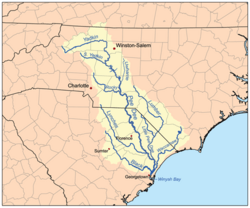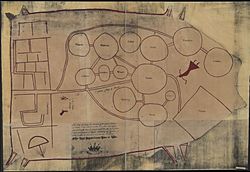Cheraw facts for kids

|
|
| Total population | |
|---|---|
| Unknown | |
| Regions with significant populations | |
| Languages | |
| Siouan language | |
| Religion | |
| Tribal religion | |
| Related ethnic groups | |
| Catawba, Saponi, Waccamaw, and other Siouan peoples |
The Cheraw people were a Native American tribe. They were also called the Saraw or Saura. They spoke a Siouan language. The Cheraw lived in the Piedmont area of North Carolina. This was near the Sauratown Mountains and the Yadkin River. They lived in villages near the Catawba River.
The first Europeans they met were with the Hernando De Soto Expedition in 1540. An early explorer, John Lawson, grouped them with other Siouan tribes. He called this group "the Esaw Nation." Later, in the late 1600s and early 1700s, the Cheraw faced attacks. They moved southeast to the Pee Dee River area. Here, the name Cheraw became more common. Over time, the tribe as a whole disappeared. However, some of their descendants still live today.
Contents
What's in a Name?
The Cheraw were first known as the Saraw. They later became known by the name of one of their villages, Cheraw. People also called them by many other names. These included Charáh, Charrows, Charra, and Saura.
The name they used for themselves is not known today. The Cherokee people called them Ani-suwa'li. The Catawba people called them Sara. This name meant "place of tall weeds." The Spanish and Portuguese called their land Xuala or Xualla.
Early English records from South Carolina sometimes used the name "Saraw."
Where Did They Live?
The Cheraw (Saura, Xualae) lived in different parts of the Southeast. They were found in areas of South Carolina, North Carolina, Virginia, and West Virginia.
In the early 1700s, the Cheraw lived in what is now Chesterfield County. This area is in northeastern South Carolina. This region was later known as "The Cheraws" or the "Cheraw Hills." Their main village was near where the town of Cheraw is today. This was close to the North Carolina border. Cheraw was one of the first towns that European Americans built inland in South Carolina.
Cheraw History
Early Life
Experts have different ideas about the Cheraw tribe's history. Some believe the Cheraw came from the Mississippian culture chiefdom of Joara. Joara was located in western North Carolina. In the mid-1500s, the Juan Pardo Expedition built a short-lived fort there. It was called Fort San Juan.
1500s: First Meetings
There are not many old records about the Cheraw. The Spanish explorer De Soto might have visited Cheraw towns in 1540. These towns were in the mountains near present-day Asheville. Their villages were next to those of the Pedee and Catawba peoples.
1600s: Moving Around
In 1600, there may have been about 1,200 Cheraw people. By 1670, they left their homes near Asheville. They moved to the lower Yadkin River. Then they moved to the Dan River in Rockingham County. By 1672, they might have moved to the Stokes County area. This was near the Sauratown Mountains.
In 1670, a German explorer named John Lederer traveled deep into North Carolina. He described a large town he called "Sara." He said the people there dug up cinnabar to make purple face paint. They also had cakes of salt. Other explorers, James Needham and Gabriel Archer, also described this town as "Sarrah" in 1671.
1700s: Challenges and Changes

Around 1710, the Cheraw faced attacks from the Seneca. The Seneca were part of the Iroquois Confederacy from the north. Because of these attacks, the Cheraw moved southeast. They joined the Keyauwee Indians tribe. The old Saura Indian villages, Lower Sauratown and Upper Sauratown, were left empty.
Some Cheraw warriors fought with the colonists in the Tuscarora War in 1712. In 1715, Cheraw warriors joined other tribes in the Yamasee War. They fought against Europeans who were enslaving Native Americans. They also fought against mistreatment and taking of their land. On July 18, 1715, a Cheraw group helped make peace. They were out of the war by October 1715.
In 1728, William Byrd explored the border between North Carolina and Virginia. He found two empty Saura villages on the Dan River. He wrote that the Seneca had attacked the Saura about 30 years before. The Saura had then moved south to the Pee Dee River area.
In 1732, the Cheraw asked to join the Saponis for protection. In 1738, a smallpox epidemic greatly reduced the number of Cheraw and Catawba people. By 1755, the remaining Cheraw joined the Waccamaw, Pedee, and Catawba tribes. They were led by King Haigler. The different tribes combined.
The Cheraw were last mentioned as a separate tribe among the Catawba in 1768. During the Revolutionary War, they moved their families to areas near Danville, Virginia. Their warriors helped the Patriot side under General Thomas Sumter.
How Many Cheraw Were There?
In 1715, a census of Native Americans was done. The Saraw were listed as living in one village. It had a population of 510 people. This included 140 men and 370 women and children. These numbers were likely estimates.
By 1768, there were only about 50–60 Cheraw people left.
Who Are Their Descendants Today?
In 1835, Cheraw descendants were part of the Catawba tribe. They were listed as "free people of color" in local records. Today, the Lumbee Indians of Robeson County, North Carolina, say they are descendants of the Cheraw. The Sumter Band of Cheraw Indians in Sumter County, South Carolina, also claims descent from the Cheraw.
Places Named After Them
- Cheraw, South Carolina, is named for the tribe.
- Cheraw, Colorado was named by an early settler from Cheraw, South Carolina.
- Cheraw, Mississippi was named by a group of Cheraw who moved there in 1810.
- South Stokes High School in Walnut Cove, North Carolina, uses the Saura tribe name for its team mascot.
- The Sauratown Mountains are named for the Saura.
Related Native American Nations
Images for kids
-
Statue of a Sauratown woman at the North Carolina Museum of History.
See also
 In Spanish: Cheraw para niños
In Spanish: Cheraw para niños


